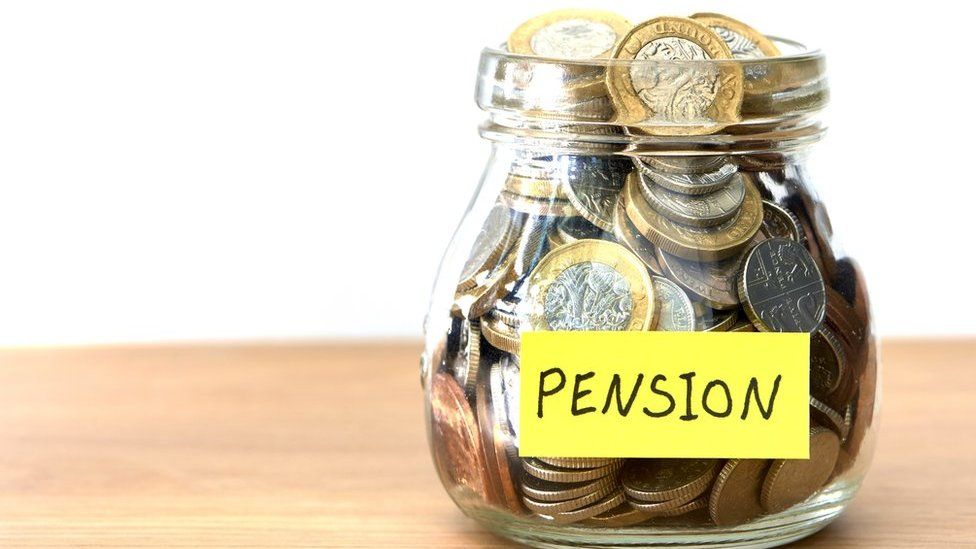Do you have a pension through work? You are fortunate if you do because they are an excellent way of maintaining your lifestyle when you are no longer working. It has been my experience that many people who have pensions don’t understand them. A pension plan is simply a retirement plan to which an employee and employer contribute while the employee is working for the employer. Like an RRSP, the contributions are invested and grow (tax deferred) until retirement, at which point the contributions are withdrawn and become income the individual can use to live on.

Retrieved from Getty Images: https://www.gettyimages.ca/detail/photo/close-up-of-coins-in-jar-on-table-royalty-free-image/1193109204?adppopup=true
There are two types of pensions: A defined benefit (DB) pension and a defined contribution (DC) pension. Their names explain their meaning. With a defined benefit pension, you know how much you will receive (the benefit) when you retire because it is based on a mathematical formula (for example, 2% times your years of service times your average salary in your last 3 years of work) whereas with a defined contribution you know how much you contribute, however, you don't know how much you will receive in retirement because it depends on how the market performs. I will focus on Defined Contribution (DC) Pensions now and I will discuss Defined Benefit Pensions in a future blog.
With DC pensions, some companies have mandatory employee contributions, mandatory employer contributions, and an optional component. The optional component is usually a percentage of salary up to a stated maximum to encourage additional savings by the employee. For example, if you contribute up to 6% of your salary your employer might match your contribution up to a maximum of $6000 a year. This matching incentive makes the DC pension more valuable than contributing to an RRSP. Therefore, if you have a plan at work that offers matching, take full advantage of it first! Your contributions to a DC plan are tax-deductible just like an RRSP. Both your contributions and your employer's contributions will count toward your RRSP contribution room. That's why it's really important to check your notice of assessment (see blog 7) to see how much contribution room you have each year.
Most DC plans offered by companies invest the contributions in mutual funds which you can select. Make sure you review the options and choose carefully because that will determine how much money you have to spend in retirement! If you have an advisor, ask him or her for help. I often review clients' DC plans to help them make the right choice. All the basic investing rules that you will learn in these blogs apply to the DC plan. And the results should be analyzed each year and any necessary adjustments made.
So what happens to the plan when you leave the company, or when you retire? You usually have the option of leaving the money in the plan or transferring it to a locked-in RRSP at a financial institution. The catch is that you won't be able to combine it with your existing RRSP if you have one. A locked-in RRSP is also called a LIRA (locked-in retirement account) and the locked-in part means that it has two special rules that are different from a regular RRSP. The first rule is that, unlike an RRSP, you can't withdraw money from a LIRA until you are 55 and, to do so, you have to convert it to a LIF (Locked-in Fund). Another interesting feature of LIRAs is that, depending on how your employer's company is registered, LIRAs have either a provincial or federal jurisdiction. Each jurisdiction has its own set of rules. If the jurisdiction is federal, there is an opportunity to unlock half of the LIF and move the half into your RRSP when you are ready to convert to a LIF. Why would you want to do that you ask? Because of the second rule. Like a RIF, there is a minimum withdrawal amount that you will have to withdraw every year. However, unlike a RIF, a LIF also has a maximum amount that you can withdraw every year. For that reason, LIFs are a lot less flexible than RIFs and, if invested properly, will often outlast their owner. I often advise my clients to take out the maximum each year in an attempt to draw down and/or deplete the LIF before they die because they are taxed the same way as RIFs with the balance on death being treated as income and taxed accordingly.
